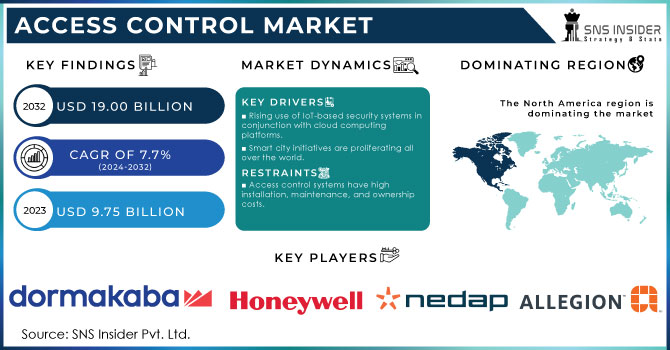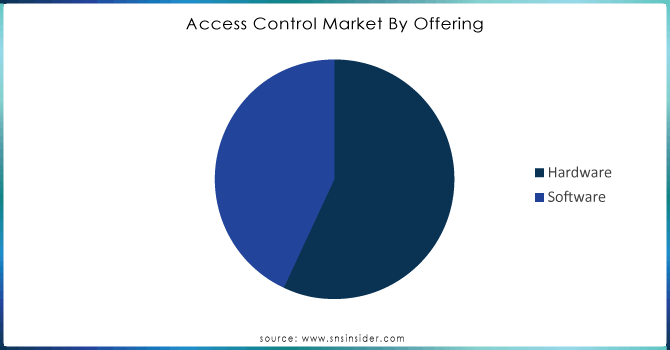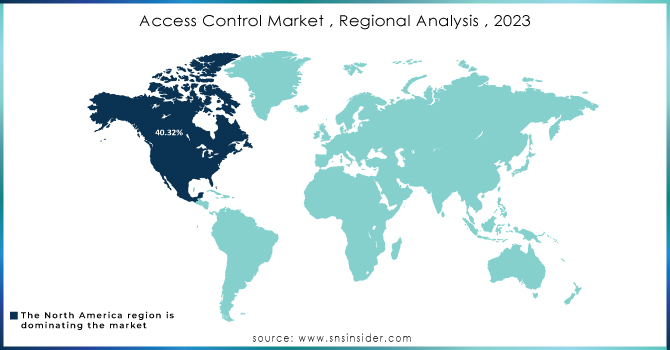Access Control Market Report Scope and Overview:
The Access Control Market size was valued at USD 11.31 billion in 2025E and is expected to reach USD 20.47 billion by 2033 and grow at a CAGR of 7.7% over the forecast period 2026-2033.
The access control market has witnessed significant growth, driven by the increasing need for enhanced security solutions across various sectors such as commercial, residential, government, and industrial applications. The widespread adoption of advanced technologies, including biometric systems, smart cards, and mobile access control solutions, has become integral in safeguarding assets and ensuring authorized access. One of the primary drivers of the access control market is the rising incidence of security breaches and identity theft, which has necessitated robust access control measures. Worldwide, in 2023 security breaches typically cost around USD 6 million on average. The system integrated biometric authentication and smart card technology to secure sensitive areas and streamline employee access management, resulting in a 30% reduction in unauthorized access incidents.

Get more information on Access Control Market - Request Sample Report
In terms of industry application, the deployment of an advanced access control system at a leading financial institution. In 2024, 60% of organizations rely on ID badge access control, but there is a noticeable shift towards smartphones as the preferred unlocking method. Amid rising hybrid work trends, 53% of organizations aim to enhance secure remote access. A USD 20 rent increase has funded access control upgrades, leading to a 39% improvement over five years, while over 70% of organizations report fewer than five major security incidents annually.
Access Control Market Size and Forecast:
-
Market Size in 2025E: USD 11.31 Billion
-
Market Size by 2033: USD 20.47 Billion
-
CAGR: 7.7% from 2026 to 2033
-
Base Year: 2025E
-
Forecast Period: 2026–2033
-
Historical Data: 2022–2024
Access Control Market Highlights:
-
Rising adoption of IoT-based security systems integrated with cloud computing platforms is driving market growth.
-
Smart city initiatives globally are increasing demand for advanced access control solutions for public safety, transportation, and resource optimization.
-
Modern access control systems offer enhanced features such as remote access, real-time monitoring, and biometric authentication.
-
Commercial, healthcare, and governmental sectors are key contributors to the growing adoption of access control systems.
-
High installation, maintenance, and ownership costs remain a major restraint, especially for small and medium-sized enterprises.
-
Regular software updates, system upgrades, and technician services add to the total cost of ownership, limiting market penetration.
Access Control Market Drivers:
-
Rising use of IoT-based security systems in conjunction with cloud computing platforms.
Smart city initiatives have been proliferating across the globe, hugely contributing to the increased demand and impressive growth of the Access Control Market. As more and more urban areas are determined to optimize their safety, law enforcement, transportation, etc., the interest in improved access control systems increases significantly. In the rapidly developing urban areas and the growing scope of information and communication technology, the concept of the smart city has become critically popular and provides broad implications for the increasing efficiency of numerous technologies. Along with IoT, access control solutions have also evolved, with the variety of features now offered, including remote access and management, real-time monitoring, biometric access, and others. Equipped with such functions, these systems further the goals of smart city initiatives by increasing the levels of public safety and facilitating more effective transportation management and resource optimization.
-
Smart city initiatives are proliferating all over the world.
Smart city initiatives have been proliferating across the globe, hugely contributing to the increased demand and impressive growth of the Access Control Market. As more and more urban areas are determined to optimize their safety, law enforcement, transportation, etc., the interest in improved access control systems increases significantly. In the rapidly developing urban areas and the growing scope of information and communication technology, the concept of the smart city has become critically popular and provides broad implications for the increasing efficiency of numerous technologies. Along with IoT, access control solutions have also evolved, with the variety of features now offered, including remote access and management, real-time monitoring, biometric access, and others. Equipped with such functions, these systems further the goals of smart city initiatives by increasing the levels of public safety and facilitating more effective transportation management and resource optimization.
Access Control Market Restraints:
- Access control systems have high installation, maintenance, and ownership costs.
The most critical factor that restrains the access control market is the high cost of installation, maintenance, and ownership of these systems. The first step, installation, implies expensive purchase and set-up of hardware, software as well as professional time. As small to medium-sized enterprises are the target audience of these systems, they might not have sufficient funds for the initial costs. Moreover, the complexity of making them interact with one’s existing infrastructure will also require a periodical financial investment in the integrator’s services. Secondly, the concept of the maintenance of such an expensive technology implies regular updates, upgrades, repair, and replacement of malfunctioning parts. To solve these problems, organizations will have to resort to experienced and knowledgeable technicians, meaning that they will be charged an extra fee for this service. Finally, ownership costs not only imply expenses on the technology itself, but also investment in the training of one’s staff in handling the equipment.
Access Control Market Segment Analysis:
By Offering
The hardware segment dominated the access control market with a market share of 54% in 2025E. Access control hardware comprises card readers, biometric scanners, electronic locks, and access control panels, among other components. The market is characterized by its ability to improve security by regulating the entry, presence, or exit of specified individuals. The market is likely to expand due to growing security issues, rising crime rates, and a greater adoption rate of IoT-based security solutions.
The software segment to have a faster growth rate during the forecast period, as this software manages user access to physical locations, digital resources, or both. Their main features are user management, access restriction, and audit trails. Such software can become a part of other security systems. More and more customers prefer cloud-based options that are compatible with mobile devices. In such a way, the software can be accessed and managed remotely.

Get Customized Report as per your Business Requirement - Request For Customized Report
By Service
The managed segment held a market share of over 40% in 2025E and it is accounted to have a faster growth during 2026-2033. Managed access control is a centralized system of access control, covering the approaches and methodologies geared towards controlling access privileges within an organization. It replaces traditional physical methods of locks and keys with a digital platform or an automated physical access control system, restraining access to entry depending on an individual’s role, set time frames, and locations. MAC has several advantages, ranging from security to ease of managing and monitoring. This method of access control effectively consolidates and streamlines all security measures of access control under one roof further enabling an organization to track access patterns.
By Industry Vertical
The commercial segment led the market with a market share of more than 35% in 2025E. Significant investments in access control systems in the commercial sector are the result of the necessity to protect various kinds of assets, data, and personnel. The equipment that falls under this segment is used to control the entry to the building, separate areas, or even pieces of equipment, allowing only those who are authorized while blocking all the others. Moreover, beyond security purposes, access control is implemented to receive such data as the dynamics of the employees’ movements, details of visitors’ entry, and many others.
The residential segment is to grow at a faster rate during 2026-2033, as such systems are a beneficial and convenient solution for ensuring security when applied for residential purposes. The technology featuring key cards, biometrics, mobile access, and other options restricts entry to the home to authorized people. This innovation contributes to safety by securing homes and property. It also provides homeowners with peace of mind by enabling them to deter entry of trespassers and allowing controlled access to enter premises. Moreover, access control systems allow managing door access remotely, which can be performed anywhere, anytime.
Access Control Market Regional Analysis:
North America Access Control Market Trends:
North America dominated the market in 2025E with a more than 40% market share. The commercial segment appears to have a prominent demand for Access control products, probably owing to the value contained and traded in this area. Due to technological advances, banks, insurance companies, hospitals, pharmaceutical companies, and governmental facilities use these systems to protect sensitive information and valuables. Notably, access systems also provide controlled access to such rooms as operation units or pharmacies in healthcare, helping to protect patients from those who are unauthorized for certain medications. The rapid spread of smart home technologies also contributes to the residential use of these solutions to give homeowners a better sense of security.
Asia-Pacific Access Control Market Trends:
The Asia Pacific region is registered to have a faster CAGR from 2026 to 2033. The growing cases of data breaches, theft, and unauthorized access have triggered the growth of the advanced access control system. Both the government and private sector are investing in high-security infrastructure to prevent any theft of information and assets. The market is driven into growth mainly by advancements in technology such as the use of biometric systems, RFID technology, and cloud-based access control systems. The innovative technology enhances high-security features, is easy to use, and well well-managed in setting access rights.
Europe Access Control Market Trends:
Europe held a significant share of the access control market in 2025E, driven by strict regulatory compliance and a strong emphasis on corporate and government security. The commercial and industrial sectors show high adoption, particularly in banking, manufacturing, and critical infrastructure facilities. Technological advancements, including cloud-based solutions, mobile credentials, and integrated building management systems, are increasingly implemented to enhance operational efficiency and security. Smart cities initiatives and rising cybersecurity awareness further bolster the demand for sophisticated access control systems across the region.
Latin America Access Control Market Trends:
Latin America is emerging as a growing market for access control systems, with adoption fueled by increasing commercial construction, financial institutions, and public infrastructure projects. High instances of theft, unauthorized entry, and security breaches in corporate and residential sectors have accelerated demand for robust access solutions. Cloud-based systems, mobile access, and biometric authentication technologies are gaining traction, driven by the need for real-time monitoring, operational efficiency, and enhanced security.
Middle East & Africa (MEA) Access Control Market Trends:
The MEA region is witnessing steady growth in access control adoption, primarily driven by infrastructural development and high-security requirements in government, oil & gas, and commercial sectors. Investments in airports, data centers, and large-scale industrial projects fuel demand for advanced biometric, RFID, and cloud-enabled systems. Rising urbanization, smart city projects, and increasing awareness of physical security solutions among enterprises and institutions further contribute to market expansion from 2026 to 2033.

Access Control Market Competitive Landscape:
Honeywell International Inc., established in 1906, is a global technology and manufacturing leader specializing in aerospace, building technologies, performance materials, and safety solutions. The company provides innovative access control, security, and automation systems, serving industries worldwide with a focus on safety, efficiency, and digital transformation.
-
In May 2024, Honeywell introduced a new cloud-based access control platform that remotely manages, mobile integration, and real-time monitoring. Honeywell has launched a cloud-based access control platform allowing its customers to manage it remotely and monitor it in real-time.
Johnson Controls International plc, founded in 1885, is a global leader in building technologies and solutions, specializing in HVAC, fire and security systems, and smart building management. The company delivers innovative access control and security solutions, enhancing energy efficiency, safety, and operational intelligence across commercial and industrial facilities worldwide.
-
In April 2024, Johnson Controls launched an advanced biometric scanner for precision, speed, and multi-factor authentication. A new biometric scanner was introduced by Johnson Controls.
Access Control Market Key Players:
-
dormakaba Holding AG
-
Johnson Controls International plc
-
Honeywell International Inc.
-
Nedap N.V.
-
Thales Group
-
NEC Corporation
-
ASSA ABLOY AB
-
Allegion plc
-
Identiv, Inc.
-
Suprema Inc.
-
Bosch Security Systems
-
HID Global Corporation
-
Gallagher Group Limited
-
Axis Communications AB
-
Stanley Security Solutions
-
Salto Systems S.L.
-
LenelS2 (Carrier Global Corporation)
-
Siemens AG (Smart Infrastructure)
-
Vanderbilt Industries
-
Gunnebo AB
| Report Attributes | Details |
|---|---|
| Market Size in 2025E | USD 11.31 Billion |
| Market Size by 2033 | USD 20.47 Billion |
| CAGR | CAGR of 7.7% From 2026 to 2033 |
| Base Year | 2025E |
| Forecast Period | 2026-2033 |
| Historical Data | 2022-2024 |
| Report Scope & Coverage | Market Size, Segments Analysis, Competitive Landscape, Regional Analysis, DROC & SWOT Analysis, Forecast Outlook |
| Key Segments | • By Offering (Hardware, Software, Service) • By Service (Managed, Hosted, Hybrid) • By Industry Vertical (Commercial, Government, Education, Manufacturing & Industrial, Military & Defense, Residential, Healthcare, Transportation) |
| Regional Analysis/Coverage | North America (US, Canada), Europe (Germany, UK, France, Italy, Spain, Russia, Poland, Rest of Europe), Asia Pacific (China, India, Japan, South Korea, Australia, ASEAN Countries, Rest of Asia Pacific), Middle East & Africa (UAE, Saudi Arabia, Qatar, South Africa, Rest of Middle East & Africa), Latin America (Brazil, Argentina, Mexico, Colombia, Rest of Latin America). |
| Company Profiles | dormakaba Holding AG, Johnson Controls International plc, Honeywell International Inc., Nedap N.V., Thales Group, NEC Corporation, ASSA ABLOY AB, Allegion plc, Identiv, Inc., Suprema Inc., Bosch Security Systems, HID Global Corporation, Gallagher Group Limited, Axis Communications AB, Stanley Security Solutions, Salto Systems S.L., LenelS2 (Carrier Global Corporation), Siemens AG (Smart Infrastructure), Vanderbilt Industries, Gunnebo AB |

